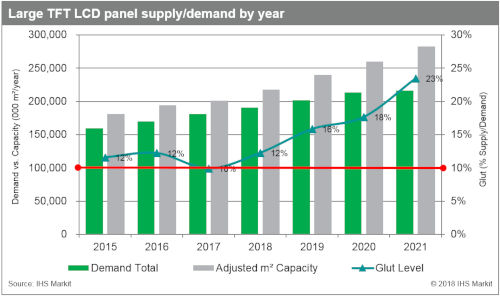Oversupply of large TFT LCD panels to prompt restructuring of older fabs
Thursday, July 19th, 2018
Long-Term Oversupply of Large TFT LCD Panels Will Prompt Restructuring of Older Fabs, IHS Markit Says
LONDON — Large thin-film transistor liquid crystal display (TFT LCD) panel makers are expected to reduce production of comparatively smaller sized 32-, 40- and 43-inch panels, helping to stabilize panel prices in the third quarter of 2018. In the longer term, however, the oversupply issue still remains, eventually causing older TFT LCD fabs to be restructured, according to IHS Markit (Nasdaq: INFO), a world leader in critical information, analytics and solutions.
According to the latest AMOLED and LCD Supply Demand & Equipment Tracker by IHS Markit, currently planned new factories will increase large display panel production capacity by 31 percent or 77.7M square meters from 2018 to 2021. However, based on the current demand forecast, there will be about 49 million square meters of capacity in the pipeline more than the market requires in 2021. The supply/demand glut level is expected to continue to increase from 12 percent in 2018 to 23 percent in 2021, remaining well above 10 percent or what is modeled to be a balanced market.

Between 2019 and 2021, there will be a great amount of LCD TV panel capacity built, mainly from generation Gen10.5/11 factories in China, according to IHS Markit.
“Some panel makers may be forced to reduce utilization rates, while some planned capacity may never be built,” said David Hsieh, senior director of displays at IHS Markit. “Furthermore, in the next few years, legacy factory restructuring will likely accelerate. For the TFT LCD industry to return to a balanced supply/demand level, multiple Gen 5, Gen 6 and even Gen 8 factories will likely need to be shut down.”
For example, shutting down half of all Gen 5 and Gen 6 amorphous silicon (a-Si) capacity in Taiwan would remove about 18 million square meters of production capacity, according to IHS Markit. Larger glass substrate capacity, such as Gen 8, will also likely need to be closed to bring the market back toward balance.
Possible restructuring of legacy factories may include fab shutdown, facility consolidation, or conversion to other technologies, such as active-matrix organic light-emitting diode (AMOLED) panels, ePaper backplanes and sensors.
According to the Display Production & Inventory Tracker by IHS Markit, fab restructuring can be attributed to multiple reasons, such as no longer competitive, old equipment, shifts in panel makers’ business focus, excessive overhead from under-utilized facilities and pressure on profitability.
“Oversupply is not the end of the crystal cycle. The industry has a long history of dynamically adjusting itself to balance supply and demand,” Hsieh said. “The process may create many challenges for supply chain companies. However, the delayed expansion of new factories, the restructuring of legacy fabs and the potential for faster demand growth spurred by lower panel prices will help the LCD industry to eventually return to equilibrium.”
Latest News
- Barb to start reporting TV-set viewing of YouTube channels
- SAT FILM selects multi-DRM from CryptoGuard
- Qvest and ARABSAT to launch OTT streaming platform
- ArabyAds & LG Ad Solutions partner with TVekstra in Turkey
- Freeview NZ satellite TV service to move to Koreasat 6
- Comscore expands YouTube CTV measurement internationally
